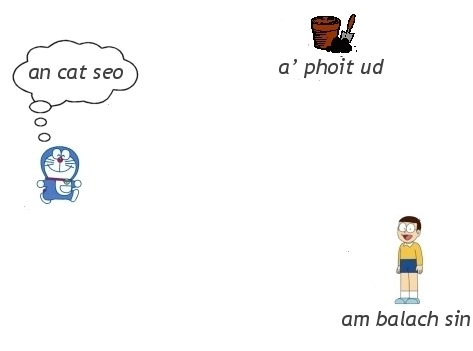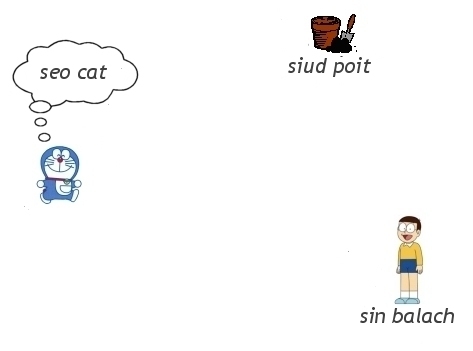An diofar eadar na mùthaidhean a rinneadh air "Demonstratives or An cat ud thall"
(Created page with "Soo ... now we've done the more difficult adverbs, we can move on to the demonstratives. Again Gaelic has the three way split between close to speaker (proximal), close to adres...") |
|||
| Loidhne 1: | Loidhne 1: | ||
| − | Soo ... now we've done the more difficult adverbs, we can move on to the demonstratives. | + | Soo ... now we've done the more difficult adverbs, we can move on to the demonstratives. Again Gaelic has the three way split between close to speaker (proximal), close to addressee (medial) and long way from either (distal). Again, Doraemon is here to illustrate: |
| − | + | {| style="width: 75%;" border="0" align="center" | |
| + | |- | ||
| + | | [[File:seo-sin.jpg|centre]] | ||
| + | |- | ||
| + | |} | ||
| − | + | You simply add seo [ʃɔ], sin [ʃin] and ud [əd] to whichever noun you wish to (which is why linguists call them enclitics - they can't go on their own and have to latch on to a noun). Note that the distinction between immediate and fuzzy location (cf an-sin vs thall) largely does not enter this arena. The one thing you can do however is to add thall to ud to give the meaning of "that thing over there" e.f. a' phoit ud thall. You can't do that with sin, neither can you add a-bhos to seo. | |
| − | It's, as you will all know, the easiest way of building a declarative sentence about | + | {| style="width: 75%;" border="0" align="center" |
| + | |- | ||
| + | | [[File:seo-sin-siud.jpg|centre]] | ||
| + | |- | ||
| + | |} | ||
| + | |||
| + | So where does siud come into it you might ask? Good question. It comes into play when you build sentences which are seemingly missing a verb, such as seo mo mhàthair, which gets translated into English 'this is my mother'. | ||
| + | |||
| + | It's, as you will all know, the easiest way of building a declarative sentence about existence in Gaelic without getting into hot water about choice of verbs etc. I suspect the s- in siud [ʃid] is simply an analogy to seo and sin (i.e. trying to make ud fit in with seo and sin) - but it might just be the verb is itself ... I'll try to find out so watch this space, but at any rate, that is how you use siud: in a declarative sentence about existence 'that's a pot', 'this is a cat', 'this is a boy' etc. This, incidentally also works with definite nouns e.g. seo an cat 'this is the cat'. Just in case you were wondering. | ||
<br /> | <br /> | ||
<br /> | <br /> | ||
{{BeaganGramair}} | {{BeaganGramair}} | ||
Mùthadh on 02:50, 19 dhen Ghearran 2012
Soo ... now we've done the more difficult adverbs, we can move on to the demonstratives. Again Gaelic has the three way split between close to speaker (proximal), close to addressee (medial) and long way from either (distal). Again, Doraemon is here to illustrate:
You simply add seo [ʃɔ], sin [ʃin] and ud [əd] to whichever noun you wish to (which is why linguists call them enclitics - they can't go on their own and have to latch on to a noun). Note that the distinction between immediate and fuzzy location (cf an-sin vs thall) largely does not enter this arena. The one thing you can do however is to add thall to ud to give the meaning of "that thing over there" e.f. a' phoit ud thall. You can't do that with sin, neither can you add a-bhos to seo.
So where does siud come into it you might ask? Good question. It comes into play when you build sentences which are seemingly missing a verb, such as seo mo mhàthair, which gets translated into English 'this is my mother'.
It's, as you will all know, the easiest way of building a declarative sentence about existence in Gaelic without getting into hot water about choice of verbs etc. I suspect the s- in siud [ʃid] is simply an analogy to seo and sin (i.e. trying to make ud fit in with seo and sin) - but it might just be the verb is itself ... I'll try to find out so watch this space, but at any rate, that is how you use siud: in a declarative sentence about existence 'that's a pot', 'this is a cat', 'this is a boy' etc. This, incidentally also works with definite nouns e.g. seo an cat 'this is the cat'. Just in case you were wondering.
| Beagan gràmair | ||||||||||||
| ᚛ Pronunciation - Phonetics - Phonology - Morphology - Tense - Syntax - Corpus - Registers - Dialects - History - Terms and abbreviations ᚜ | ||||||||||||

